[ad_1]
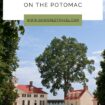
Go World Travel is reader-supported and may earn a commission from purchases made through links in this piece.
On November 26, 1777, Henry Knox wrote to General George Washington stating that, “the People of America look up to you as their Father, and into your hands they entrust their all.” Thus, he was thrust into the patriarchal role of Father of our Country.
There are certain “truths” that you learn in grade school that you hold dear and resurrect to pass on as fact to younger generations reinforcing legends of our heritage.
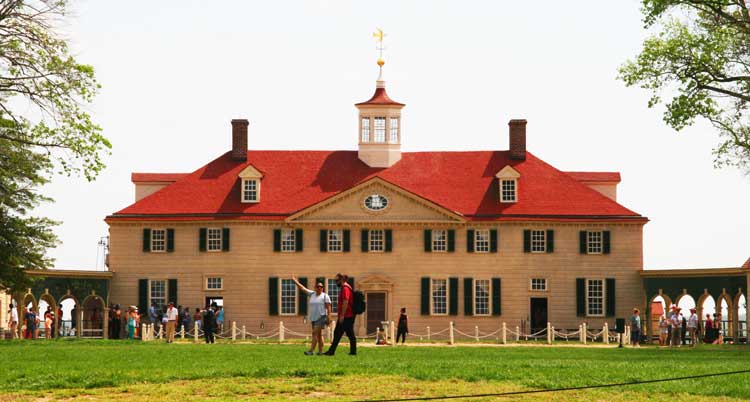 Mount Vernon is a two-and-a-half story, 11,028-square-foot stately home with twenty-one rooms
Mount Vernon is a two-and-a-half story, 11,028-square-foot stately home with twenty-one rooms
Common Misconceptions About George Washington
So, it is with great dismay when you learn that these long-held truths are fallacies. Such as when I learned that the greatest example of honesty, a youthful George Washington’s declaration, “I cannot tell a lie…I did cut down the cherry tree,” is nothing but a myth or to put it more ironically, a lie.
Or the grand exemplar tale of strength in which our famed General flung a silver dollar across the Potomac River. Nope, never happened. The Potomac River is over a mile wide at Mount Vernon. Even George Washington did not have the arm to fling a silver dollar that far.
Even the most conventional of tales, that the First President’s teeth were wooden, proved to be stilted. While Washington certainly suffered from dental problems, his dentures were composed of a variety of materials – including lead, gold, and even hippopotamus ivory but not hickory.
My wife and I learned all of this and a great deal more during our recent visit to Mount Vernon in Fairfax County, Virginia.
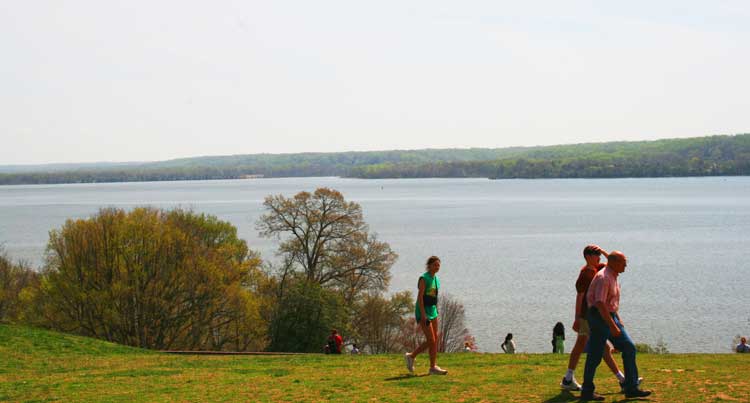 George Washington’s beloved Potomac River as seen from the porch. Photo by Frank Hosek
George Washington’s beloved Potomac River as seen from the porch. Photo by Frank Hosek
Washington’s Love of the Potomac
George and Martha Custis Washington’s Mount Vernon is located on a bluff with a fine panoramic view of the Potomac, which he referred to as, “one of the finest Rivers in the world.”
George Washington was a native of the Potomac tidewater, and he loved the river. With reluctance each time, he left Mount Vernon to serve in public or military office; he stated that Mount Vernon’s frontage on the river was “my door.”
Read More: A Monumental Experience – Summiting the Washington Monument
A Tour Through Mount Vernon
We were late in arriving for our timed entry into the mansion, tickets that we had bought online, so we hurriedly raced through the visitor center hoping to make our entry time
As we trotted up the semi-circular, crushed stone carriage path we slowed momentarily as the quintessential homestead came into view. Its historical contours were quickly recognizable to both of us and surprisingly far greater in size than either of us had expected.
The soft buff colored façade with the split-wood crimson red roof topped by the striking octagonal cupola dominated the horizon.
A sympathetic docent took our tickets and told us to join the end of the line. A soft breeze floated off the river, across the wide lawn easing the heat of the late morning’s cloudless sky.
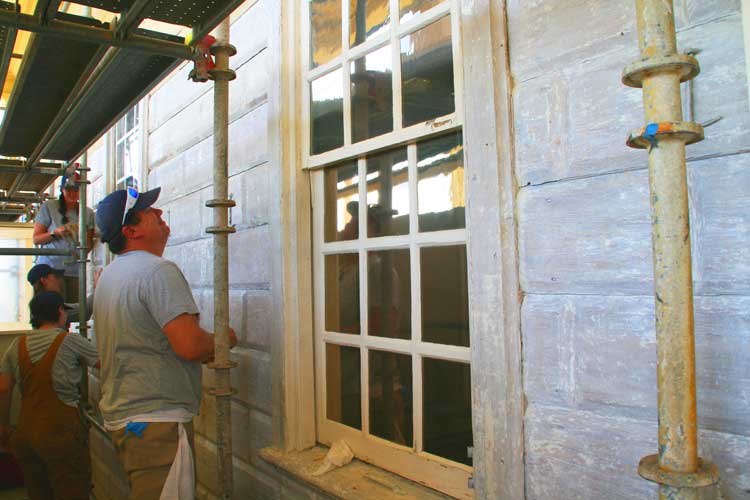 Restoring the exterior’s faux stone surface through a process of rustication. Photo by Frank Hosek
Restoring the exterior’s faux stone surface through a process of rustication. Photo by Frank Hosek
Mount Vernon’s Careful Construction
As we stood awaiting our turn, I reflected on how little I actually knew of George Washington. Of course, he was the nation’s first president. The general that led a break-away nation through 8 years of struggle towards eventual independence from England. And, certainly, I knew that Mount Vernon was his home.
Beyond that, my education was lacking. First off, the immensity of the estate surprised me. As large as the current 500 acres represent, it is a fraction of the original 8,000 acres.
The second item we learned was contrary to appearances, Mount Vernon is not built of stone. While we were there, workers were restoring the east or river side of the exterior using what they referred to as a “rustication process.”
Washington had saved costs by simulating a stone exterior. It’s actually wooden siding. Rustication involves carving beveled edges into pine planks and then applying paint mixed with sand to give the wood a grainy texture, mimicking stone.
The two-story porch facing the Potomac River is one of the Mansion’s most iconic architectural features and was designed by Washington. However, on this day due to the restoration process, the façade was covered in scaffolding and tarps. When I asked one of the restorers how often the exterior had to be repainted, he replied that it was last painted in 2012. However, at that time, it had not been scraped all the way down to the bare wood.
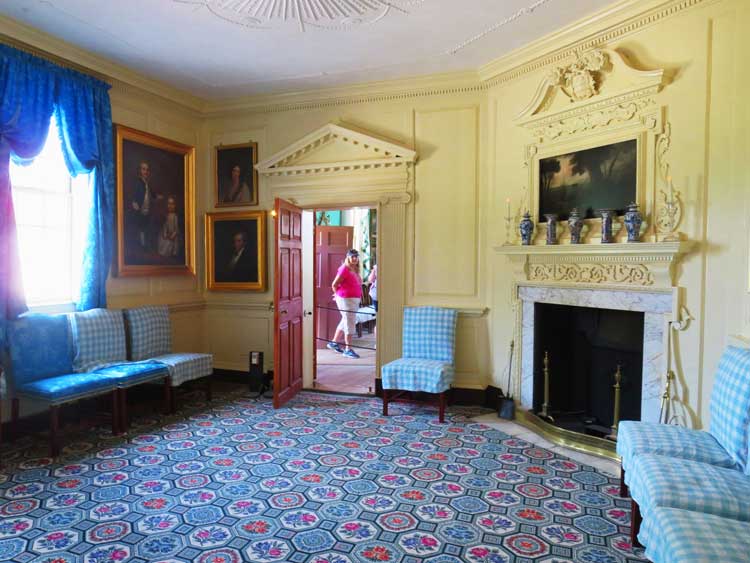 One of the most elaborately finished rooms in the house, the front parlor served as the primary entertaining space in the Mansion for most of the Washingtons’ lives. Photo by Frank Hosek
One of the most elaborately finished rooms in the house, the front parlor served as the primary entertaining space in the Mansion for most of the Washingtons’ lives. Photo by Frank Hosek
Mount Vernon’s Long History of Renovations
When George Washington began living at Mount Vernon in 1759, it was a quarter the size that it is today.
Over the next four decades, Washington renovated Mount Vernon’s main house into a two-and-a-half story, 11,028 square foot stately home with twenty-one rooms.
We were directed into the house to the New Room, as Washington called it, where we could see how he hoped to impress with this last addition to the house. It’s two-story-high ceiling, detailed architectural ornamentation, and stylish furnishings were meant to entertain and beguile all those who entered, including us.
We exited onto the piazza-styled porch from where we reentered the house through the central hall, past the Front Parlor, which was the original formal guest area and is an elaborately furnished room. From there to the dining room. The dining room stopped me in my tracks.
I had been impressed by the architectural symmetry and stylings of the mansion. Washington had been instrumental in the designs and colors used throughout. However, the walls of this room were painted in a strikingly garish green paint that Washington believed to be “grateful to the eye”. I found the color rather ghastly and questioned its effect on one’s digestion.
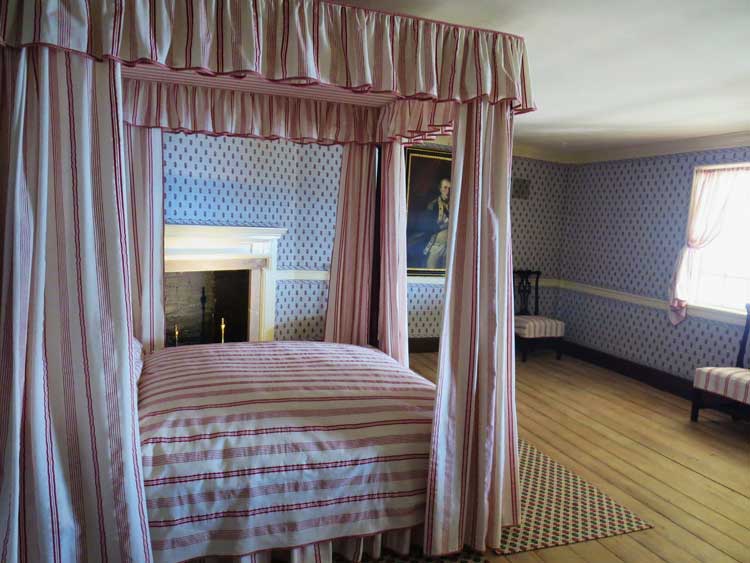 The largest guest bedroom was the bed chamber where Lafayette stayed, in the northeast corner of the second floor, continued to be associated with its most famous occupant. Photo by Frank Hosek
The largest guest bedroom was the bed chamber where Lafayette stayed, in the northeast corner of the second floor, continued to be associated with its most famous occupant. Photo by Frank Hosek
George Washington’s Most Esteemed Guest
Climbing the central stairway, we were directed to the largest guest bedroom of six in the northeast corner of the second floor, which will forever be referred to as the Lafayette Room.
Marquis de Lafayette, the young Frenchman who so faithfully served Washington during the revolution, visited the Washingtons’ in 1784 and resided in this room for several weeks. Hung on the wall is a portrait of a youthful but determined Lafayette.
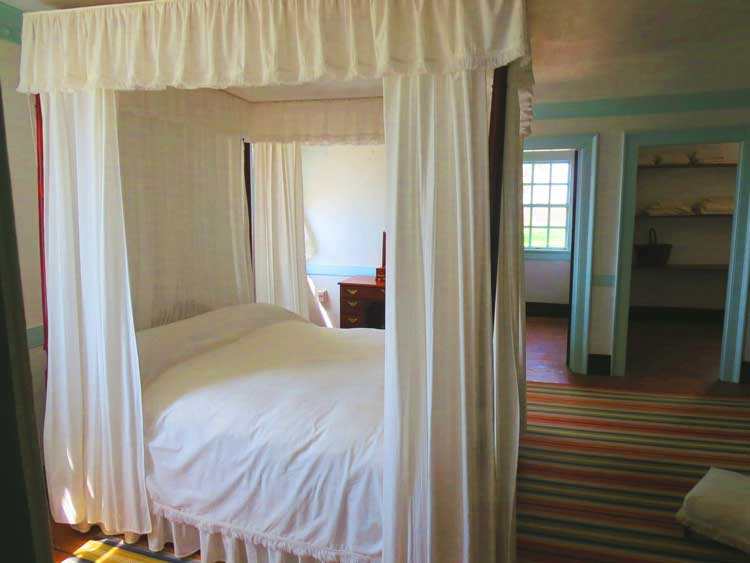 George and Martha’s bedroom with the bed in which George passed away. After his death, Martha closed up the bedroom. Photo by Frank Hosek
George and Martha’s bedroom with the bed in which George passed away. After his death, Martha closed up the bedroom. Photo by Frank Hosek
Washington’s Surprisingly Lackluster Bedchamber
Also, on the second floor, we were led to Washington’s Bedchamber, where Washington died of a severe throat infection on December 14, 1799.
The original oversized bed, which accommodated the 6’ tall President, is where he breathed his last. Strikingly, Washington’s bedroom was very lacking in color, somewhat sterile compared to the lavishly tinted balance of the household.
The Kitchen, Smokehouse, and Outbuildings of Mount Vernon
Back outside, we explored the oversized kitchen, separated from the main house by a causeway. This was where enslaved cooks arose at four each morning to light the fire in the oven and prepare the meals to be served in the Mansion. Their duties could continue well into the evening.
Not far from the kitchen was located the smokehouse. This is where, long before refrigeration, vast quantities of pork—mainly bacon and ham—were smoked.
For long-term storage after smoking, the meats remained hanging. In this day and age, it seems less than palatable, but smoked meats can last for months to years.
Beyond were several more outbuildings, barns and fields providing a glimpse of 18th-century livelihood.
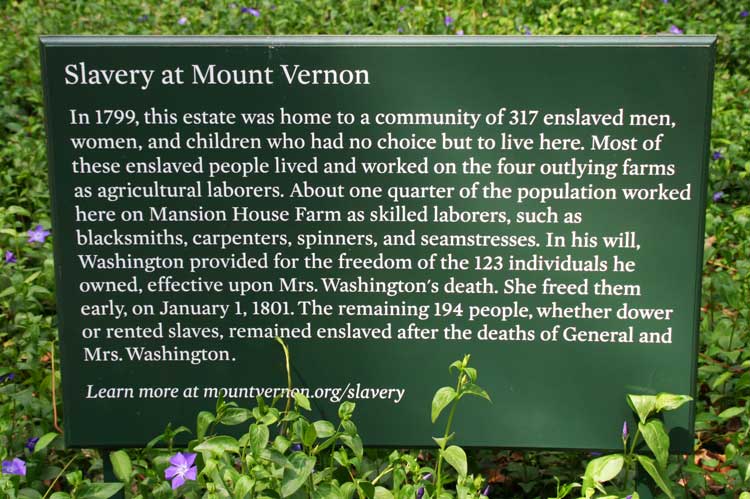 Slavery was an inescapable reality of Mount Vernon. Photo by Frank Hosek
Slavery was an inescapable reality of Mount Vernon. Photo by Frank Hosek
READ MORE: 400th Anniversary: U.S. Historic Sites Explore the Truth About Slavery in America
The Burden of Slavery at Washington’s Estate
In discovering the length and breadth of the estate we could not ignore what it took to run it and who did the chores. Like many of the founding fathers, Washington’s plantation was the forced home to over 300 slaves. Their labor was relied upon to build and maintain his household and plantation.
One of the more sobering aspects of our visit was The Slave Memorial. Located in a grove overlooking the Potomac River, it marks the site where the enslaved people and a few freedmen were buried in unmarked graves.
As he aged, Washington seemed to recognize his never-ending entanglement of slavery, but could not bring himself to escape it while alive. Upon his and Martha’s deaths, his will freed nearly half of the slaves. Unfortunately, those owned by the Custis estate were inherited by Martha Washington’s grandchildren.
It was a reflection of the young nation’s struggles with an apparition that was to haunt it for years to come.
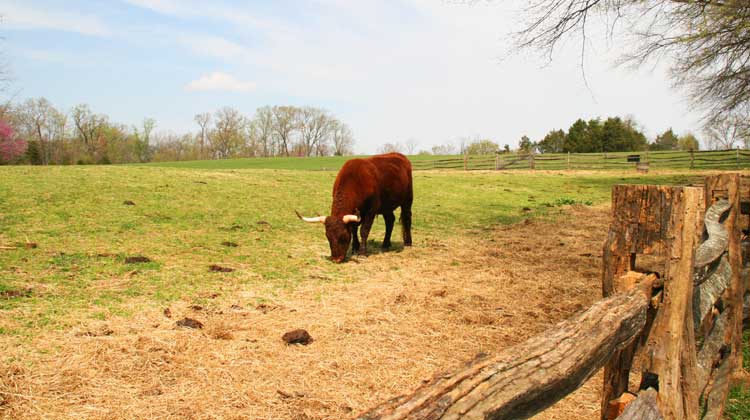 Mount Vernon is home to several farm animals on the massive property. Photo by Frank Hosek
Mount Vernon is home to several farm animals on the massive property. Photo by Frank Hosek
Mount Vernon’s Expansive Grounds and Washington’s Legacy
The grounds are expansive and with the museum and education center. It would have taken us the entire day to truly give Mount Vernon its due. Unfortunately, we had allowed for only half that. It will be well worth another visit. I did leave with a couple of facts that will add to my understanding of Mr. Washington and his life.
Surprisingly, the estate is managed by the Mount Vernon Ladies’ Association, not the federal government. After seeing the dilapidated state of the President’s home, Ann Pamela Cunningham founded the organization that purchased the estate in 1859. The Association has maintained its preservation and restoration ever since and is privately funded.
The last of several surprises we learned on our visit is that George and Martha were laid to rest in a mausoleum on the grounds and, fittingly, remain so today.
George Washington had overseen almost every detail of the mansion, always making sure the estate reflected his distinguished status. He even did so as he served in the Revolutionary War and as president of the United States.
Unfortunately, between the Revolution and his Presidency, Washington spent less than 8 of his final 23 years at Mount Vernon.
In 1798, 18 months before his death, he noted in a letter that “my whole life has been dedicated to the Service of my Country.”
In this, he did not tell a lie.
If You Visit:
https://www.mountvernon.org/
George Washington’s Mount Vernon is located roughly 15 miles south of Washington, D.C. and 8 miles south of Alexandria, Virginia. Mount Vernon is open 365 days a year, including holidays.
More helpful links:
[ad_2]
Source link
Jarastyle – #George #Washingtons #Legacy #Potomac
Courtesy : https://www.goworldtravel.com/mount-vernon-george-washingtons-legacy-on-the-potomac/?utm_source=rss&utm_medium=rss&utm_campaign=mount-vernon-george-washingtons-legacy-on-the-potomac

